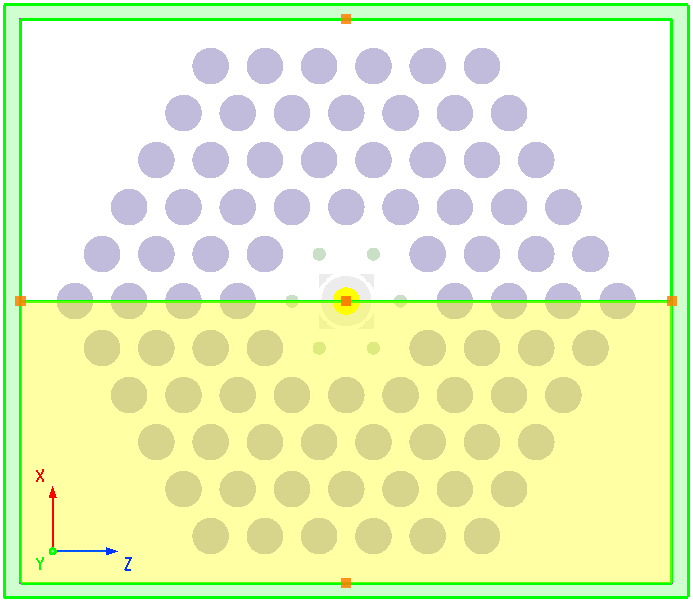Contact Number
Email
 Enterprise WeChat
Enterprise WeChat WeChat Service Account
WeChat Service Account
 Wechat Channels
Wechat ChannelsThis section describes the settings for FDTD solvers.
Select the FDTD button in the Home tab and click any empty space in the Composite viewer to create an FDTD solver. Then modify the settings of the FDTD solver in the automatically pop-up Edit properties interface to complete the addition of the FDTD solver.
The General tab is used to set the simulation space (including simulation and geometric dimensions) for the solver.
The Dimension and polarization tab is used to set the simulation dimensions for the FDTD solver.
| Name | Description |
|---|---|
| 2D Polarization | TE: TE-polarization, for example: including three components , , ; TM: TM-polarization, for example: including three components , , . |
| 3D | 3D simulation. |
| 2.5D | 2.5D simulation. |
The Geometry tab is used to set the geometric dimensions of the FDTD solver.
| Name | Description |
|---|---|
| Z/X/Y pos | Set the geometric center position of the solver simulation domain. |
| Z/X/Y span | Set the geometric width of the solver simulation domain in the 3D coordinate direction. |
The 2.5D settings tab is only enabled when the simulation dimension is set to 2.5D.
For detailed parameter settings, see 2.5D settings.
The Background material tab provides the Background material drop-down menu for users to select background materials.
| Name | Description |
|---|---|
| Background material | The background material library, including materials from the Global library. You can also use the Add/Edit in the Project library to create project-specific materials as background materials |
After selecting a background material, its relevant information (Name, Type, Last modified, etc.) is displayed simultaneously.
The Time tab provides the settings related to simulation time and automatic shutoff.
The Simulation time tab provides the settings for simulation time.
| Name | Description |
|---|---|
| Simulation time | Note the time unit. |
| Simulation steps | The number of discrete time steps divided throughout the entire simulation process; a read-only parameter. |
The Auto shutoff tab is used to set the parameters related to automatic shutoff of the simulation.
| Name | Description |
|---|---|
| Early shutoff | Check to enable this option. |
| Auto shutoff ratio | Determine whether to terminate the simulation early based on the ratio of the remaining energy to the incident energy in the simulation region at the current moment. |
| Numerical divergence | Determine numerical divergence. Check to enable this option. |
| Auto shutoff maximum threshold | Determine the maximum threshold of auto shutoff of simulation divergence. Determine the ratio of the remaining energy to the incident energy in the simulation, and once this threshold is exceeded, the simulation is considered to be divergent and terminates automatically. |
| Per time steps(sampled time) | Check the sampling time used in the automatic shutoff rate; that is, after how many time steps a sample is taken during the simulation process. At the sampling time step, the software checks whether the remaining energy in the simulation meets the conditions for early termination of the simulation. |
The Mesh tab provides the mesh settings for solvers.
For detailed parameter settings, see Mesh.
The Boundary conditions tab provides the boundary condition settings for solvers.
For detailed parameter settings, see Boundary Conditions.
The Advanced tab provides the advanced settings for solvers.
By default, material fitting is based on the wavelength range of the source. If users need to fit material models beyond the range of the source, they need to set the simulation bandwidth. Once the simulation bandwidth is configured, the software will automatically perform material fitting within the specified range instead of being limited to the wavelength range of the source. This is particularly important for exciting nonlinear responses of light outside the wavelength range of the source. Additionally, after adjusting the simulation bandwidth, this option will also affect the generation of the non-uniform mesh and the bandwidth settings of monitors.
The Mesh generate tab includes the following settings:
| Name | Description |
|---|---|
| Force symmetric x/y/z mesh | Forced mesh symmetry in the x/y/z direction. Only the positive-axis half of the simulation region needs to be considered; the mesh of the negative-axis half replicates that of the positive-axis half. This option is very practical for simulations with structural symmetry. |
| Override bandwidth for mesh generation | This option is used to define the bandwidth for mesh generation and allows generation of simulation meshes based on user-defined wavelength ranges. |
| Snap pec to yee cell boundary | This option mandatorily requires all PEC structures to align with Yee cell boundary, ensuring that the electric field components at PEC interfaces maintain a tangential distribution. Enabled by default, this option should remain selected in antenna engineering applications to enhance the accuracy of radiation efficiency calculations. |
The Force symmetric x/y/z mesh option is very practical for simulations with structural symmetry, such as for a defective photonic crystal resonant cavity, It is necessary to maintain mesh symmetry and minimize numerical errors arising from mesh asymmetry.

By default, the non-uniform mesh is generated based on the wavelength range of the source. However, for simulations involving nonlinear effects, this setting may not take into account the high-frequency components generated by the nonlinearity, potentially leading to systematic errors in the simulations. To avoid this problem, users can click Override bandwidth for mesh generation, which forces the use of an appropriate wavelength range to generate the non-uniform mesh. This option only affects the generation of non-uniform grids and has the highest priority. The priority for determining the wavelength range for non-uniform mesh generation is as follows: Override bandwidth for mesh generation > set simulation bandwidth > source wavelength.
Enabling the Snap pec to Yee cell boundary option eliminates numerical complexities caused by nullifying normal electric field components at PEC interfaces. This feature is widely used in antenna radiation engineering applications and is equally essential for mode-solving at PEC boundaries. During simulation mesh generation, the software automatically calibrates specified PEC boundaries to achieve precise alignment, permitting a maximum offset of dx/2 (where dx denotes the Yee cell dimension).
As shown in the figure: In the horizontal direction, if the PEC structure extends less than dx/2 beyond the grid lines, the index distribution stays unchanged (PEC aligns with inner grid lines). In the vertical direction, if the PEC structure extends dx/2 beyond the grid lines, the index distribution expands outward to align the PEC with outer grid lines.

When the Real-time display of slice fields option is enabled, the following parameters need to be set by users:
| Name | Description |
|---|---|
| Save time point | All sampling time steps: Based on the user-defined sampling time step, data sampling or recording of simulation results occurs at specific time points during the simulation process. |
| Sample type | Select the sampling method for transient fields. Step: Sample the transient field in time steps; Time: The transient field is sampled based on the actual time of the physical field (in ps). |
| Sample time steps/sample time(ps) | Adjust different settings depending on the selected sample type. Sample time steps: The time step interval for sampling during the simulation process, i.e. the number of time steps after which the field is sampled or the results are recorded; Sample Time (ps): The time interval of the actual physical field sampled during the simulation process, i.e. how much time (in ps) has elapsed since the physical field was sampled or the results were recorded once. |
| Total sample time steps | Calculate the number of sampling times required to complete the simulation based on two time sampling methods. |
| Sample time steps match auto shutoff | When this option is enabled, the Sample time steps tab is read-only. |
Once these options have been set, further settings can be made in the FDTD simulation control panel Simulation Control Panel. For details, see Setting FDTD Simulation Control Panel.
In time-domain field transmission, the Use complex field FDTD option allows for the calculation of a complex-valued time-domain field.